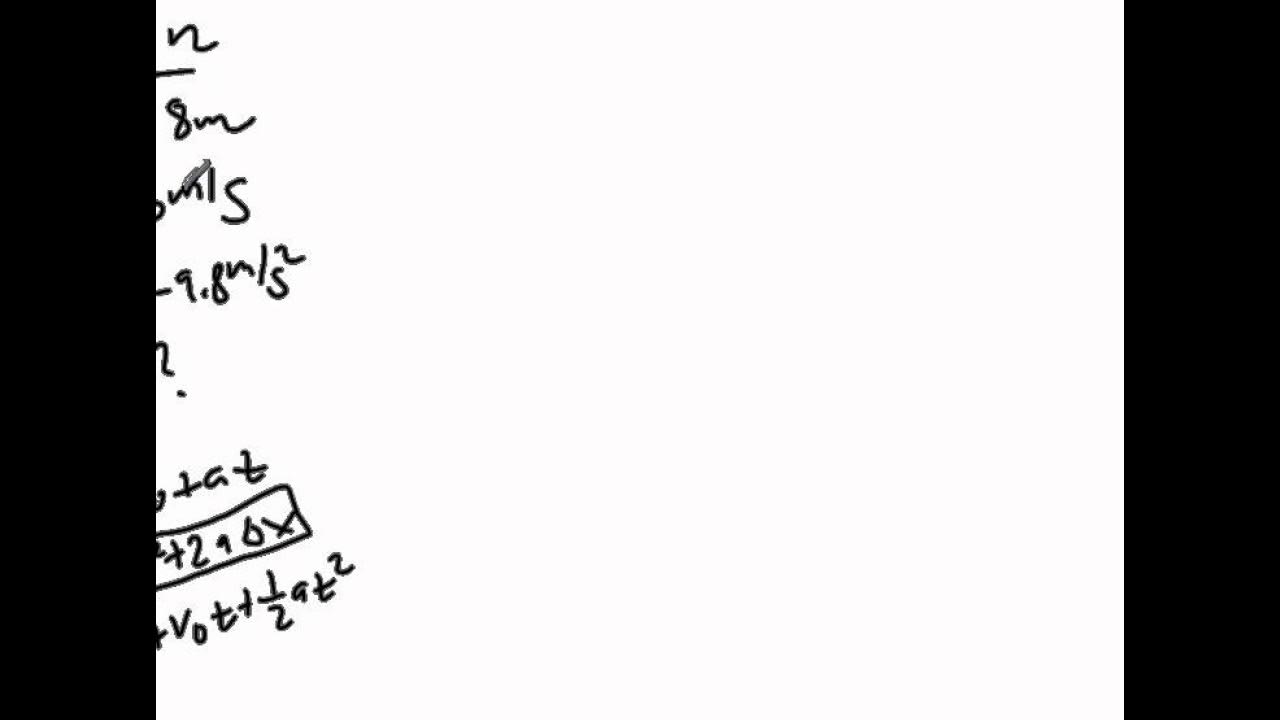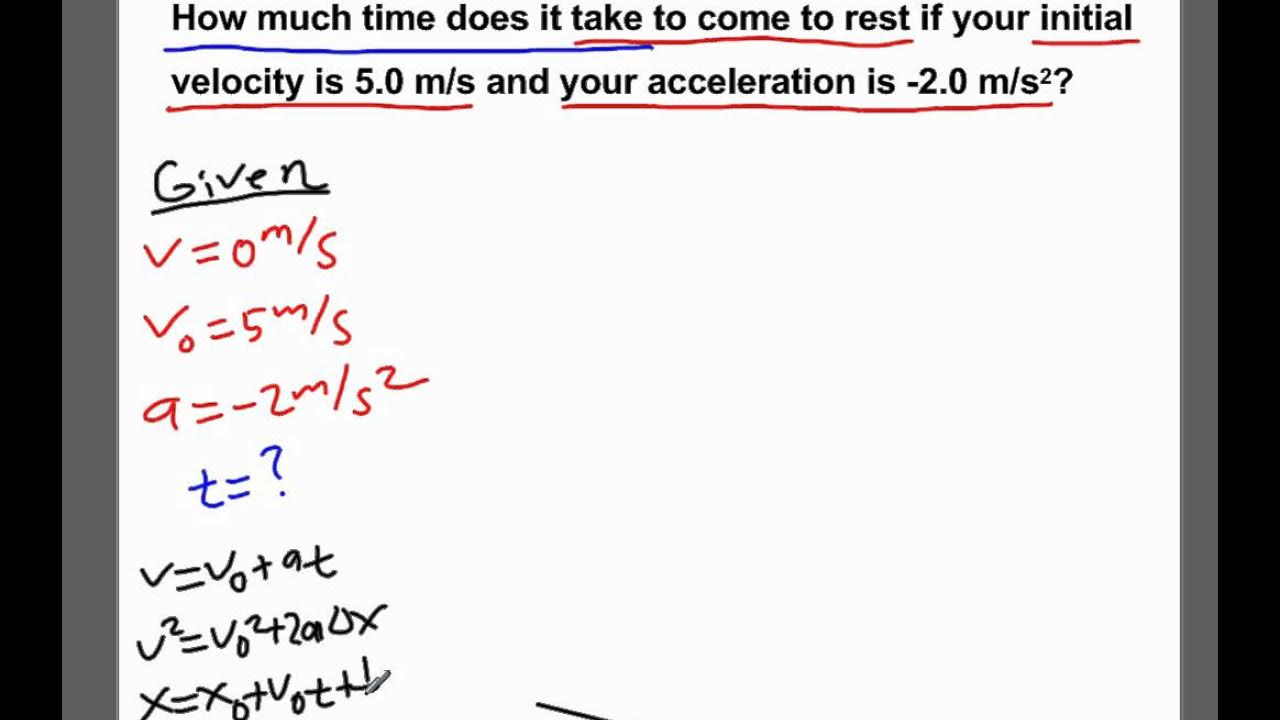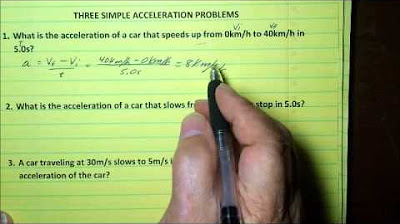AP Physics B Kinematics Presentation #31
TLDRThe video script demonstrates how to calculate acceleration using the kinematic equation \( v^2 = v_0^2 + 2a\Delta x \). Starting with initial and final velocities of 20 m/s and 60 m/s, respectively, and a distance traveled of 200 meters, the script guides through the steps of isolating acceleration 'a'. By substituting the given values, the script concludes with an acceleration of 8 meters per second squared, showcasing a clear and methodical approach to solving physics problems.
Takeaways
- 🚀 The problem involves calculating acceleration over a given distance with known initial and final velocities.
- ⏱ The initial velocity given is 20 meters per second, and the final velocity is 60 meters per second.
- 📏 The distance traveled during the acceleration is 200 meters.
- 🔍 Three kinematic equations are presented: v = v₀ + at, v² = v₀² + 2ad, and x = x₀ + v₀t + 1/2at².
- 📘 The chosen equation for solving the problem is v² = v₀² + 2ad, as it relates initial and final velocities and displacement.
- 📝 The process involves isolating 'a' (acceleration) by manipulating the equation to a = (v² - v₀²) / (2d).
- 🔢 The calculation steps include subtracting v₀² from both sides and then dividing by 2d.
- 📉 Squaring the final and initial velocities gives 3600 m/s² and 400 m/s² respectively.
- 📈 The acceleration is found by dividing the difference of these squared velocities (3200 m²/s²) by twice the distance (400 m).
- 🔑 The result of the division simplifies to 32/4, which equals 8 m/s², representing the acceleration.
- 📚 The units of acceleration are correctly identified as meters per second squared.
Q & A
What is the initial velocity mentioned in the script?
-The initial velocity mentioned in the script is 20 meters per second.
What is the final velocity in the given scenario?
-The final velocity is 60 meters per second.
What is the total distance traveled in the problem described?
-The total distance traveled is 200 meters.
Which kinematic equation is chosen to solve for acceleration in the script?
-The kinematic equation chosen to solve for acceleration is \( v^2 = v_0^2 + 2a\Delta x \).
What is the first step in solving for acceleration according to the script?
-The first step is to subtract \( v_0^2 \) from both sides of the equation to isolate the term with acceleration.
What is the result of the equation after subtracting \( v_0^2 \) from both sides?
-The result is \( 2a\Delta x = v^2 - v_0^2 \).
How is the acceleration 'a' isolated in the equation?
-The acceleration 'a' is isolated by dividing both sides of the equation by \( 2\Delta x \).
What is the formula for acceleration after isolating 'a'?
-The formula for acceleration is \( a = \frac{v^2 - v_0^2}{2\Delta x} \).
What are the values substituted into the formula for the final and initial velocities?
-The values substituted are 60 m/s for the final velocity and 20 m/s for the initial velocity.
What is the calculated acceleration in meters per second squared?
-The calculated acceleration is 8 meters per second squared.
How does the script ensure the units are correct for acceleration?
-The script ensures the units are correct by showing the cancellation of meters squared in the numerator and denominator, leaving meters per second squared.
Outlines
🚀 Calculating Acceleration Using Kinematic Equations
This paragraph explains the process of calculating acceleration given initial and final velocities and the distance traveled. The initial velocity is 20 m/s, the final velocity is 60 m/s, and the distance covered is 200 meters. The speaker chooses the kinematic equation \( v^2 = v_0^2 + 2a\Delta x \) to solve for acceleration 'a'. By rearranging the equation to isolate 'a', the formula becomes \( a = \frac{v^2 - v_0^2}{2\Delta x} \). Plugging in the given values, the calculation yields an acceleration of 8 m/s², which is the final result after simplifying the expression.
Mindmap
Keywords
💡initial velocity
💡final velocity
💡distance
💡acceleration
💡kinematic equations
💡v squared equals v naught squared plus 2a delta x
💡solve for a
💡v squared minus v naught squared
💡200 meters
💡8 meters per second squared
Highlights
Initial velocity given as 20 meters per second.
Final velocity is 60 meters per second.
The distance traveled is 200 meters.
The objective is to calculate acceleration.
Three kinematic equations are presented.
The chosen equation is v^2 = v₀^2 + 2aΔx.
The equation is rearranged to solve for acceleration.
Subtracting v₀^2 from both sides isolates the acceleration term.
Dividing by 2Δx gives the formula for acceleration.
Plugging in the given values to find acceleration.
Final velocity squared is calculated as 3600 m/s².
Initial velocity squared is 400 m/s².
The acceleration formula is simplified to a = (v² - v₀²) / (2Δx).
The calculated acceleration is 32 m/s² divided by 4.
The final acceleration result is 8 m/s².
The units of acceleration are confirmed as meters per second squared.
The process checks for the correct value and units of acceleration.
Transcripts
5.0 / 5 (0 votes)
Thanks for rating:





